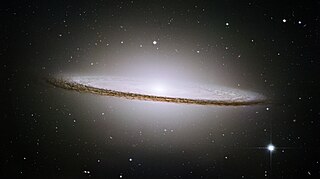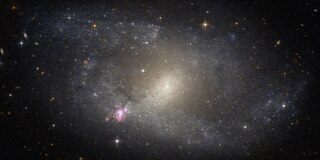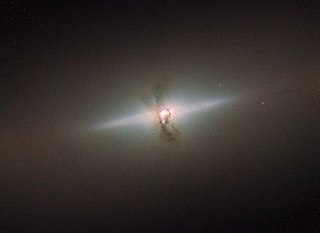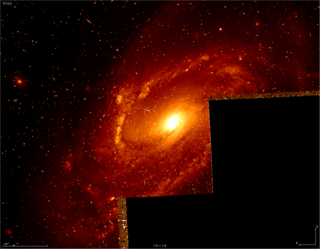
The Sombrero Galaxy is a peculiar galaxy of unclear classification in the constellation borders of Virgo and Corvus, being about 9.55 megaparsecs from the Milky Way galaxy. It is a member of the Virgo II Groups, a series of galaxies and galaxy clusters strung out from the southern edge of the Virgo Supercluster. It has an isophotal diameter of approximately 29.09 to 32.32 kiloparsecs, making it slightly bigger in size than the Milky Way.

NGC 5866 is a lenticular galaxy in the constellation Draco. NGC 5866 was most likely discovered by Pierre Méchain or Charles Messier in 1781, and independently found by William Herschel in 1788. Measured orbital velocities of its globular cluster system imply that dark matter makes up only 34%±45% of the mass within 5 effective radii, a notable paucity.

A polar-ring galaxy is a type of galaxy with an outer ring of gas and stars that rotates over the poles of the galaxy. These polar rings are thought to form when two galaxies gravitationally interact with each other. One possibility is that a material is tidally stripped from a passing galaxy to produce the polar ring. The other possibility is that a smaller galaxy collides orthogonally with the plane of rotation of the larger galaxy, with the smaller galaxy effectively forming the polar-ring structure.

NGC 278 is an isolated spiral galaxy in the northern circumpolar constellation of Cassiopeia, near the southern constellation boundary with Andromeda. It lies at a distance of approximately 39 megalight-years from the Milky Way, giving it a physical scale of 190 ly (58 pc) per arcsecond. The galaxy was discovered on December 11, 1786 by German-born astronomer William Herschel. J. L. E. Dreyer described it as, "considerably bright, pretty large, round, 2 stars of 10th magnitude near".

NGC 5398 is a barred spiral galaxy in the southern constellation of Centaurus. It was discovered June 3, 1836 by John Herschel. Distance estimates range from 5.39 Mpc to 18.30 Mpc. The tip of the red-giant branch method yields a distance of 11.6 Mpc, while the Tully–Fisher relation shows values of around 8.5 Mpc. It is receding with a heliocentric radial velocity of 1,219 km/s.

NGC 4536 is an intermediate spiral galaxy in the constellation Virgo located about 10° south of the midpoint of the Virgo cluster. However, it is not considered a member of the cluster. Rather, it is a member of the M61 Group of galaxies, which is a member of the Virgo II Groups, a series of galaxies and galaxy clusters strung out from the southern edge of the Virgo Supercluster. The morphological classification in the De Vaucouleurs system is SAB(rs)bc, which indicates it is a weakly barred spiral galaxy with a hint of an inner ring structure plus moderate to loosely wound arms. It does not have a classical bulge around the nucleus.

NGC 2748 is a spiral galaxy in the northern circumpolar constellation of Camelopardalis, located at a distance of 61.3 megalight-years from the Milky Way. It was discovered September 2, 1828 by John Herschel. The morphological classification of SAbc indicates this is an unbarred spiral with moderate to loosely-wound spiral arms. It is a disk-like peculiar galaxy with a stellar shell that is rotating about the main galactic axis. This shell was most likely formed through the capture and disruption of a dwarf companion. The galactic nucleus likely contains a supermassive black hole with a mass of 4.4+3.5
−3.6×107 M☉, or 44 million times the mass of the Sun.

NGC 3862 is an elliptical galaxy located 300 million light-years away in the constellation Leo. Discovered by astronomer William Herschel on April 27, 1785, NGC 3862 is an outlying member of the Leo Cluster.

NGC 7552 is a barred spiral galaxy in the constellation Grus. It is at a distance of roughly 60 million light years from Earth, which, given its apparent dimensions, means that NGC 7552 is about 75,000 light years across. It forms with three other spiral galaxies the Grus Quartet.

NGC 4111 is a lenticular galaxy in the constellation Canes Venatici. It is located at a distance of circa 50 million light-years from Earth, which, given its apparent dimensions, means that NGC 4111 is about 55,000 light-years across. It was discovered by William Herschel in 1788. NGC 4111 possesses both thin and thick discs.

NGC 4689 is a spiral galaxy located about 54 million light-years away in the constellation of Coma Berenices. NGC 4689 is also classified as a LINER galaxy. NGC 4689 is inclined at an angle of about 36° which means that the galaxy is seen almost face-on to the Earth's line of sight. NGC 4689 was discovered by astronomer William Herschel on April 12, 1784. The galaxy is a member of the Virgo Cluster.

NGC 4660 is an elliptical galaxy located about 63 million light-years away in the constellation Virgo. The galaxy was discovered by astronomer William Herschel on March 15, 1784 and is a member of the Virgo Cluster.

NGC 759 is an elliptical galaxy located 230 million light-years away in the constellation Andromeda. NGC 759 was discovered by astronomer by Heinrich d'Arrest on September 17, 1865. It is a member of Abell 262.

NGC 1386 is a spiral galaxy located in the constellation Eridanus. It is located at a distance of circa 53 million light years from Earth, which, given its apparent dimensions, means that NGC 1386 is about 50,000 light years across. It is a Seyfert galaxy, the only one in Fornax Cluster.

NGC 691 is an unbarred spiral galaxy located in the constellation Aries. It is located at a distance of circa 120 million light years from Earth, which, given its apparent dimensions, means that NGC 691 is about 130,000 light years across. It was discovered by William Herschel on November 13, 1786.

NGC 6902 is an unbarred spiral galaxy located in the southern constellation of Sagittarius at an approximate distance of 124 million light-years (38.0 Mpc). NGC 6902 was discovered on September 2, 1836 by English astronomer John Herschel. In his New General Catalogue, Danish astronomer J. L. E. Dreyer described it as faint, considerably small, round, brighter middle. It is a member of the small NGC 6092 group of galaxies; the LGG 434 group

NGC 1241 is a spiral galaxy located in the constellation Eridanus. It is located at a distance of circa 150 million light years from Earth, which, given its apparent dimensions, means that NGC 1241 is about 140,000 light years across. It was discovered by William Herschel on January 10, 1785. It is classified as a Seyfert galaxy.

NGC 4324 is a lenticular galaxy located about 85 million light-years away in the constellation Virgo. It was discovered by astronomer Heinrich d'Arrest on March 4, 1862. NGC 4324 has a stellar mass of 5.62 × 1010M☉, and a baryonic mass of 5.88 × 1010M☉. The galaxy's total mass is around 5.25 × 1011M☉. NGC 4324 is notable for having a ring of star formation surrounding its nucleus. It was considered a member of the Virgo II Groups until 1999, when its distance was recalculated and it was placed in the Virgo W Group.

NGC 7625, or Arp 212, is a peculiar galaxy in the constellation of Pegasus. It was discovered on October 15, 1784, by William Herschel. In his New General Catalogue (1888), J. L. E. Dreyer described it as pretty bright, considerably small, round, with a suddenly much brighter middle. It is located at an estimated distance of 78 million light-years from the Milky Way galaxy.




















